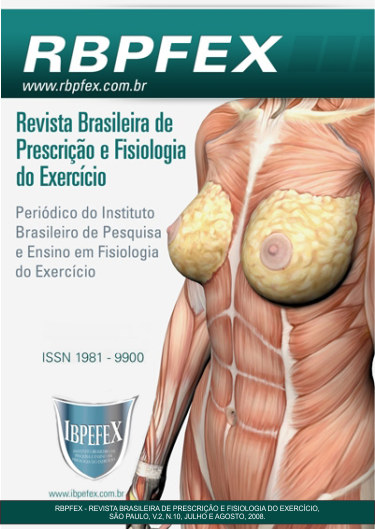Behavior glycemic before and after lesson of jump with hydratation of water and water more sugar and salt
Abstract
Introduction: In practice drills, mainly run in hotenvironments perspiration is the only means of dissipation of heat. In addition to helping in thermoregulation, also removes water and electrolytes mainly sodium from the body. Existing thus little doubt that the proper hydration favors physiological functions, performance and health especially in individuals who practice exercises. Objective: The objective of this study is to show whether the ingestion of water diluted with a quantity of sugar and salt during physical activity will influence the glucose immediately after the end of the year or if the influence is more relevant in the hydration and performance as shown in the review literary. Materials and Methods: It held a class of jump with duration of 40 minutes with 20 women aged between 25 to 50 years where a group ingested water and other water more sugar and salt. Results: In tests observed - if a drop in the average glycemic of both groups being that the group that ingested water more sugar and salt suffered glycemic biggest change in the fall. Discussion: Being able to have suffered interference in the amount of sugar and salt used in the solution and the length of time after activity for the test glycemic. Conclusion: Thus the carbohydrate significantly influence the performace of the year and the source of energy production in individuals who practice physical activity.
References
- Coleman, E. Aspectos Atuais Sobre Bebidas para Esportista. Gatorade Sports Science Institute. São Paulo. Vol. 3. 1995. p. 6.
- Coyle, E.F; Mountain, S.J. Thermal And Cardiovascular Responses to Fluid Replacement During Exercise. Perspectives in exercise science and sports Medicine. V. 6: 1993. p: 179 -224.
- Ivy, J.L. Role of carbohydrate in physical activity. Clin Sports Med. 1999; n° 18. p. 469–84.
- Kazapi, I.A.M.; Albiero, K.A.; Stümer, K. Aspectos para Minimizar os Efeitos Adversos da Prática Esportiva no Carlor. Revista Nutrição em Pauta. São Paulo, p. 19-24, 2005.
- Krause, M.L.K., Escott – Stump, S. Alimentos, Nutrição e Dietoterapia. 9. Ed. São Paulo; Roca, 1998.
- Lieberman, H.R.; Falco, C.M.E.; Slade, S.S. Carbohydrate administration during a day of sustained aerobic activity improves vigilance, as assessed by a novel ambulatory monitoring device, and mood. American Society for Clinical Nutrition. N° 76. 2002. p. 120 – 7.
- McCardle, W.D.; Katch, F.I.; Katch V.L. Nutrição para o Desporto e Exercício. Rio de Janeiro: Guanabara Koogan, 2001. p. 252-279.
- Nadel, E.R. Novas Idéias Para a Reidratação Durante e Após os Exercícios no Calor. Exchange 07, disponível em Internet. http://www.gssi.com.br/scripts/outros. Acesso em 16 agosto de 2005.
- Novaes, J.S. Personal Training e Condicionamento Físico em Academia, Rio de Janeiro: Shape, 2003.
- Pereira, B.; Souza Júnior, T.P. Metabolismo Celular e Exercício Físico – Aspectos Bioquímicos e Nutricionais. São Paulo: Phorte, 2004.
- Wilmore, J.H.; Costil, D.L. Fisiologia do Esporte e do Exercício. 2. Ed. São Paulo: Manole, 2001.
Authors who publish in this journal agree to the following terms:
- Authors retain the copyright and grant the journal the right of first publication, with work simultaneously licensed under the Creative Commons Attribution License BY-NC which allows the sharing of the work with acknowledgment of the authorship of the work and initial publication in this journal.
- Authors are authorized to enter into additional contracts separately for non-exclusive distribution of the version of the work published in this journal (eg, publishing in institutional repository or book chapter), with acknowledgment of authorship and initial publication in this journal.
- Authors are allowed and encouraged to post and distribute their work online (eg, in institutional repositories or on their personal page) at any point before or during the editorial process, as this can bring about productive change as well as increase impact and impact. citation of published work (See The Effect of Free Access).






